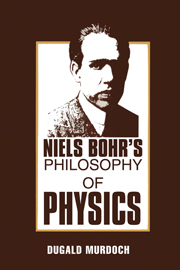Book contents
- Frontmatter
- Contents
- Dedication
- Preface
- Acknowledgements
- 1 Wave-particle duality
- 2 Niels Bohr and wave-particle duality
- 3 From duality to complementarity
- 4 The meaning of complementarity
- 5 The foundations of kinematic-dynamic complementarity
- 6 Bohr's theory of measurement
- 7 Bohr's theory of properties
- 8 Einstein versus Bohr
- 9 The sequel to the Bohr-Einstein debate
- 10 Bohr's philosophy of physics
- 11 An appraisal of Bohr's philosophy of physics
- Notes
- Index
6 - Bohr's theory of measurement
Published online by Cambridge University Press: 01 June 2011
- Frontmatter
- Contents
- Dedication
- Preface
- Acknowledgements
- 1 Wave-particle duality
- 2 Niels Bohr and wave-particle duality
- 3 From duality to complementarity
- 4 The meaning of complementarity
- 5 The foundations of kinematic-dynamic complementarity
- 6 Bohr's theory of measurement
- 7 Bohr's theory of properties
- 8 Einstein versus Bohr
- 9 The sequel to the Bohr-Einstein debate
- 10 Bohr's philosophy of physics
- 11 An appraisal of Bohr's philosophy of physics
- Notes
- Index
Summary
I propose now to examine Bohr's informal theory of measurement from a somewhat more formal point of view, and to consider how his theory relates to the orthodox theory of measurement in quantum mechanics. This is a difficult task, since Bohr nowhere discusses the theory of measurement in formal terms. My discussion, therefore, will be less closely tied to Bohr's own statements. I shall also consider some important objections to the theory.
The objective-values theory of measurement
Before we look into this theory, it will be useful to have a brief sketch of some of the relevant formal elements of quantum mechanics.
In the Hilbert space formulation of quantum mechanics the measurable physical properties (‘observables’) of an object are represented by linear Hermitian operators A, B, … which have complete orthonormal sets of eigenvalues an, bn, … corresponding to the subspaces (closed linear manifolds) of a Hilbert space H. These operators are in one-to-one correspondence with the projection measures PA, PB, … on the Hilbert space such that PA = ΣnanPn, where Pn are the projections of the eigenvectors ψn belonging to the eigenvalues an of A, and an are discrete, non-degenerate values (for simplicity I shall deal only with operators which have such values, and shall denote observables and the corresponding operators by the same symbols).
- Type
- Chapter
- Information
- Niels Bohr's Philosophy of Physics , pp. 109 - 133Publisher: Cambridge University PressPrint publication year: 1987



